Step-by-step instructions on how to grow mint on the windowsill yourself
Fresh herbs for tea drinks, salads, green smoothies and other products are a luxury available to many. Not everyone knows how to grow mint on the windowsill without problems, so they doubt the success of the undertaking. Recommendations and advice will help you understand the types and varieties of grass, get a harvest of fragrant green leaves.
Features of growing mint on a windowsill
The plant was named after a nymph from the underworld. According to ancient Greek myth, Minta was too impudent, for which she paid - she was turned into garden grass. The old Russian name "chill" was given for its taste. English, noble, tea mint in Russia is called a hybrid Mentha piperita.
Choose the lightest place in the apartment for the mint. Direct rays at noon can cause burns to the aboveground part and heat the soil in the pot very much. In addition, under the influence of sunlight, the essential oil evaporates, the leaves lose their cooling taste. It is necessary to shade the plant or find a place with good diffused lighting.
Please note: Peppermint and its varieties grow quickly with a long daylight hours, fills the entire pot with rhizomes, shoots, multiplies easily.
You will need a large ceramic or plastic pot as rhizomes like space. There must be drain holes for excess water to exit. The plant does not tolerate waterlogging.
What else to consider when growing mint on a windowsill or balcony. Fresh leaves contain more menthol - a substance that gives a cooling taste and aroma. The concentration of essential oil is higher in properly dried whole leaves. After collection, during drying, a significant part of the menthol is volatilized.
Use fresh herbs of your own production, brew as tea, prepare drinks, homemade tinctures. Dried raw materials are also widely used: for flavoring tea, improving taste and enhancing the effect of medicinal preparations. Mint is safe for children and the elderly. The plant is traditionally considered a "female" herb, but also benefits the male body.
Suitable species, varieties and varieties
Mentha is a genus of perennial grasses of the Lamiaceae family. Many shoots extend from a branched rhizome, located almost horizontally, and thin roots. Mint is used as a pot and container plant. The main thing is to provide sufficient lighting, regular watering.
Mentha piperita - M. pepper
It is a hybrid of two natural species (M. spikelet and M. aquatic). The stem is 20 to 60 cm high, tetrahedral, branched, densely leafy, reddish at a young age. The leaves contain a variety of essential oil glands.
Spikelet inflorescences are located in spike-shaped inflorescences at the tops of the stems. Corollas are small, pale purple, lilac or pinkish. Flowering begins in June and lasts until autumn.
Peppermint rich in menthol. When rubbed or touched while leaving, the grass emits a pleasant aroma-chill. This hybrid is popular as a tea, medicinal, cosmetic plant.
Peppermint subspecies: black with reddish-purple hues, white with light green stems and leaves. Black mint is grown for the industrial production of essential oils and menthol. The essential oil of the white variety is more delicate.
Window sill and balcony varieties:
- "Lemon", "Orange", "Bergamot". The leaves are rich in menthol, antioxidants, used for drinks, decorating various dishes, improving the taste of sauces, compotes, jams. The aroma corresponds to the "speaking" names.
- "Apple". Leaves with a delicate taste, fresh apple notes. The variety is popular for fresh salads, drinks, ice cream.
- "Strawberry". Suitable for balcony cultivation. The leaves taste like ripe strawberries.
- "Chocolate". Leaves with taste and aroma of mint chocolate. Fast growing variety.
It is difficult for a layman to recognize a plant without a label, "badge". You can choose according to the description the most suitable in height, requirements for care, use.
Other popular types and varieties of mint
Spikelet M. is a plant with curly leaves. Pubescence in the form of short hairs. The flowers are white or pinkish. The species is poorer in essential oil and menthol than modern varieties, therefore it is less valued in medicine and cooking.
Water mint is a plant up to 90 cm high, with pink globular inflorescences, ovoid leaves and pubescent stems. Long-leaved M. has an impressive size (up to 1 m and more), more suitable for growing in the garden.
The varieties of mint "Banana", "Pineapple" are obtained on the basis of several species and hybrids. Use the leaves with a delicate fruity aroma and delicate taste for sweet dishes and drinks. Mojito is especially good for soft drinks. Moroccan mint, which is gaining popularity in Western Europe, may lack sun in central Russia.
Reproduction methods
Natural species easily reproduce by pieces of rhizomes give small seeds that are carried by the wind, water, animals. Seed propagation of almost half of the hybrids at home is available only to the most experienced growers. When choosing the most suitable plants for the windowsill, it should be borne in mind that the methods of propagation and care of different varieties of mint are very similar.
You can buy seedlings or an adult potted plant from specialty stores and garden centers. Houses should be planted or transplanted into a larger pot or container.
Reproduction methods mint at home:
- Sowing seeds (not for all hybrids and varieties).
- Cuttings, rooting of green shoots in water or wet substrate.
- Planting pieces of rhizome with buds and roots.
- Division of the mother bush
The advantage of vegetative methods (the last three numbers in the list) is that the resulting young plants always inherit the varietal qualities of the mother bush. If you collect the seeds yourself, they will not sprout or look like the original variety.
Seeds
Mint hybrids prevail in modern floriculture - they are richer in essential oil, more decorative. However, during the breeding process, plants often lose their ability to produce germinating seeds. Therefore, this method of reproduction is not for everyone. If you buy quality seeds from a flower shop or garden center, it is easier to get strong seedlings of your favorite variety.
Procedure:
- Fill a pot or container with loose soil.
- For even distribution, premix the seeds with clean sand.
- Moisten the soil with clean water from a spray bottle.
- Sow seeds to a depth of no more than 5 mm, sprinkle with soil.
- Cover the container with a plastic bag or plastic wrap with holes for gas exchange.
Mint seeds germinate best in warm, moist soil. Seedlings appear in 2-3 weeks. If sown on seedlings at the end of February, then in March in March the first shoots are visible. Prepare containers and soil for future bushes in advance. When 2 true leaves appear on the shoots, transplant the strongest plants into separate containers or one large pot. Elongated, withered, yellow - discard.
An adult bush
It is not necessarily a large plant. The first green shoots of mint after wintering in a room on a windowsill may be weak.The main thing is that the underground part has living buds and roots. Divide the large bush into several parts. Sprinkle the cut points with crushed charcoal.
Plant the cuttings in pots filled with fertile soil, water. Place the containers on a light windowsill away from the radiators. With proper care, mint quickly forms dense green shoots, gives the first fragrant leaves. Feed with a solution of 1 g of urea in 1 liter of water.
Cuttings
Prepare the planting material from cut mint shoots 15–20 cm long. The stronger and denser the lower part, the more chances for the early emergence of roots. Remove the bottom two leaves on each cutting and place in glasses of water. Accelerates the emergence of roots by pre-soaking shoots in a stimulant (Kornevin, Epin).
The roots will begin to grow back in 7-15 days. Add a mild urea solution at this time. Plant cuttings with well-developed roots in pots with a diameter of at least 30 cm with fertile soil.
Prerequisites: lighting, temperature, humidity
Indoors, it is easier to provide a favorable temperature regime for mint, which is in the range from 20 to 25 ° C. In summer, with long daylight hours and bright lighting before lunchtime, regular watering, the plants give many new shoots and develop well. Mint should not be allowed to bloom on the windowsill. This takes away nutrients from the leaves, impairs the viability of the bushes.
Lighting in autumn and winter is more difficult, so mint often suffers from a lack of sun indoors. There is one-sided light on the windowsill, its intensity is lower than on the street. The mint pot must be rotated to achieve even growth.
The duration of lighting in autumn and winter should be at least 4 hours. If it is not possible to supplement the lighting of the plants, then it is necessary to transfer the pots to a bright room with a temperature of 15-17 ° С, reduce watering. Juicy, fragrant leaves will appear in spring and summer.
Water the mint regularly, twice a day during the hotter months. If the air in the room is dry, place a container with water for evaporation next to the pots. The need for watering decreases as the air temperature drops.
How to plant
The choice of soil and capacity is very important for the growth of the rhizome - the basis for a rich harvest of leaves.
Preparation of containers, planting material, soil
Prepare everything you need before boarding. The ceramic pot is often covered with a green bloom of algae. Plastic double flowerpots, containers are more practical, cheaper. The larger the plant to be planted, the wider and deeper the container should be.
You will need mature shrubs, seedlings or rooted mint cuttings. The planting material must be healthy, without damage. It is better to cut the upper part for better survival. Sections should be sprinkled with wood ash or crushed activated carbon.
The versatile substrate can be purchased at the supermarket or you can make your own potting soil. Mint grows best in fresh, loose soil, enriched with all the essential nutrients. A slightly acidic or neutral substrate with a pH in the range of 5 to 7 is required.
Prepare the substrate from two parts of garden soil, one part of humus, the same amount of peat and washed sand. Another potting soil recipe: two parts garden soil, one part humus. Mix all components, pour into containers for plants.
Planting instructions
It is not recommended to plant mint too thickly. One green shoot 15 cm high in three summer months is able to fill a flowerpot with a diameter of 40-50 cm with its rhizomes and green shoots!
Procedure:
- Fill the bottom of the container with drainage material. Use pieces of styrofoam or expanded clay. Can be replaced with gravel or broken bricks.
- Pour some of the prepared potting mix on top of the drainage, compact a little and water.
- Place a well-rooted stalk, seedling, or mint bush in the water well.
- Cover the roots with the remaining soil, tamp.
- Pour again and sprinkle with a pinch of sand on top.
- Cover the plants with large plastic cups.
Plant the mint in pots, containers, or boxes 15 cm apart. You can leave more room for one bush. This promotes better air circulation and reduces the risk of mold.
Mint in a spacious container does not need to be transplanted annually. In this case, change the topsoil in the spring. Add a substrate with mineral and organic fertilizers, microelements.
Care for mint on the windowsill: watering, feeding, pruning, wintering
The plant does not require any special care. Peppermint loves moisture, but does not tolerate excess water. Water it 2-3 times a week, in the summer - 1 or 2 times a day. Check first if the topsoil is dry. Spray the plants with water occasionally. Loosen the topsoil to allow gas exchange.
Fertilize the soil before planting or replanting mint. Feed once every 2 weeks in the spring. If the soil is severely depleted, then the growth of the shoots is impaired. Peppermint reacts well to nitrogen fertilizers. Urea or carbamide is quickly absorbed by the roots. For feeding, use a solution of 1 g per 1 liter of water.
Advice! Do not apply fertilizer immediately before or during flowering and harvesting.
Leave the mint growing on the balcony in a large flowerpot or container to winter in the same place. Cut off the aerial portion in the fall. Place the container on a Styrofoam plate to protect the rhizome from freezing temperatures. Cover with peat, dry leaves, sawdust or cover with spruce branches, drape with burlap on top.
Possible problems, mistakes, diseases, pests
Peppermint is susceptible to fungal infections. Signs of trouble: white bloom, brown spots on the leaves, impaired growth and development. The most harmful fungi: rust, powdery mildew, verticillium wilting, anthracnose. Errors in care, such as excessive watering, frequent feeding with nitrogen fertilizers, contribute to the defeat.
Usually, sulfur preparations are used against fungal diseases in the form of a powder or sprayed with solutions of colloidal sulfur (1%), Bordeaux liquid (1%). It is especially difficult to combat powdery mildew and verticillary wilting. Severely affected plants are destroyed, the soil is frozen or calcined in the oven.
Attention! The most effective method of fighting fungus on indoor flowers is to completely replace the pot, soil, and plant.
The list of mint pests is also extensive. Dangerous for the "chill" mint flea. The insect looks like a small yellow bug. Another pest is the mint leaf beetle. The small green beetle is not as dangerous as its voracious larvae. Aphids form colonies on the leaves - clusters of tiny dark green insects. Plants are damaged by mint mites, meadow moths, wireworms, leafhoppers, weevils.
In case of severe pest infestation, you can spray with a solution of Actellik. Carry out processing no later than mid-May. Later, use a strong decoction of celandine, tobacco or nettle with the addition of soap for spraying.
Ripening terms
Start cutting mint in June, when the shoots reach a height of 20 to 30 cm. However, the leaves are richest in essential oil before flowering. Pruning stimulates the awakening of the buds on the rhizome and the regrowth of new shoots, does not allow the plant to waste energy on flowers.
The active growth of mint continues until August. In three months, you can get 2 full harvests of fragrant leaves. Shoots grow "in waves": the very first are ready for cutting in June, others "ripen" by July or August.
Harvesting
Cut leaves can be immediately brewed with a pinch of black or green tea, added to dessert, or made into a cocktail. Such consumption of mint from a pot on a windowsill is available almost all year round.
Mint tops with flowers are not harvested for drying or freezing. They contain little essential oil and are therefore not suitable for tea or salads.Shoots before flowering are considered mature, suitable for mass collection.
Use clean, sharp scissors or a knife to cut. Harvest in the morning. Tear off only the leaves, they are richer in essential oil. Alternatively, cut off the shoots by 2/3, dry them whole, spreading them in a thin layer on a paper towel.
Important! There is no need to cut the raw materials into pieces, as is done in pharmacies. The essential oil volatilizes during grinding.
Dry mint in a ventilated room, without access to the sun, turn the raw materials daily. Properly dried herb retains its natural green color, pleasant "cooling" aroma, and a slightly pungent taste. The faster the drying process, the more nutrients it contains.
Storage and processing methods
Place the grass in a thick paper or cloth bag. Store no more than two years in a dry place. Dried mint often loses its pleasant aroma and flavor. There are other processing methods: freezing, maceration with oil, infusion in vodka. Try to use only fresh mint sprigs for cocktails.
Rapid cooling to temperatures below –18 ° C helps to preserve almost all nutrients, the aroma of vegetables, fruits, herbs. Spread the freshly picked mint in portions in plastic bags, put in the ice compartment for a day. Herb briquettes retain their aroma for 6 months. Use mint without defrosting for soups and sauces, flavoring drinks.
Mix a handful of fresh shoots with olive or other vegetable oil in a bottle. Close the lid tightly. Insist in a warm place for 21 days. Shake daily. It turns out a fragrant oil for salads.
Mint is infused in high-quality vinegar, vodka. In the first case, it is better to use a collection of herbs. Use flavored vinegar for pickles, salads, skin care.
Use a tincture of vodka or moonshine externally to reduce itching and burning after insect bites, add to a solution for rinsing your mouth, throat, hair, and facial lotion. Can be taken orally for coughs, indigestion, flatulence. The method is simple: add 30-50 drops to 50 ml of water, drink 3 such doses in sips a day.
Mint is well known to gardeners, cooks, doctors, and herbal medicine fans. The plant is easy to keep in a room on a windowsill. A fragrant herb in a pot requires easy maintenance, thanks generously for taking care of the harvest of cooling leaves.
Watch a video tutorial on growing mint at home from seeds:



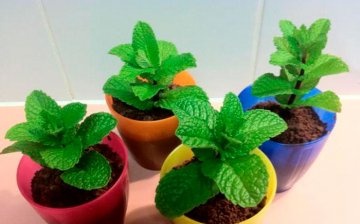
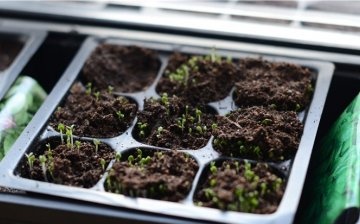




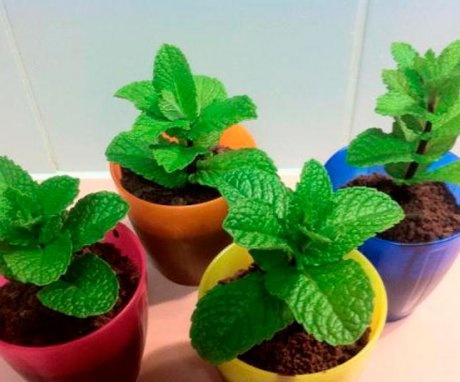
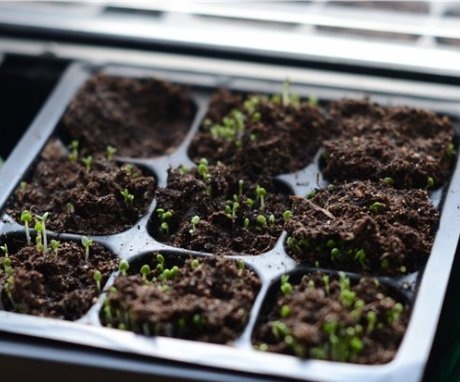
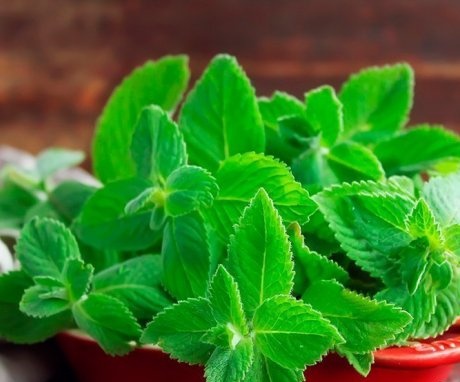
For about 4 years, mint has been growing in my apartment on the windowsill. In summer, it suffers from heat and sun, the leaves turn yellow. But in the autumn and winter, with additional supplementary lighting with energy-saving lamps, it grows excellently. Cut, dry and add to tea. The winter harvest is richer than the summer.
He began to breed mint in one pot, and then propagated it by rooting the branches. Now the plantation is completely occupied by the windowsill.
Didn't know that mint can be grown on the windowsill. I like to drink tea with mint and compote, these fragrant leaves can be added. It's not clear, just what does it mean not to let the mint bloom, to pluck the flowers?
Young shoots that grew from a bud on the root did not bloom for me. After cutting, below the cut, young shoots grow from the bud above each leaf. Here they can bloom. But twigs usually bloom after the second pruning. I cut off the tops, where flowering was indicated, not allowing to bloom. Otherwise, the leaves are small and not as fragrant. And the flowers themselves do not smell good. Then I cut off the whole branch to the very root. This provokes the plant to grow young roots and young twigs from the root.
It's a good idea to grow mint, the windowsill will be busy with benefit, once upon a time melissa was accidentally grown in a pot, but for some reason after that we did not grow it in separate pots.